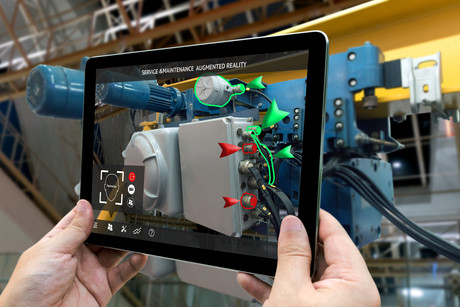Driving the digital transformation with augmented reality
By Peter Herweck, Executive Vice President, Industry Business, Schneider Electric
Wednesday, 09 May, 2018

More than one billion smartphone users worldwide will create or view augmented reality (AR) content in 2018, according to Deloitte Global predictions. At its core, AR blends the real environment — what you see, unassisted, in front of your own eyes — and a virtual, computer-generated environment.
Applications in the consumer space, such as gaming, retail and interior design, are already gaining traction — and highlight the potential of this technology to enhance experiences and drive deeper product engagement.
But dig a little deeper and it becomes clear that AR has the power to transform the manufacturing sector too — offering factory owners and operators a completely new way of engaging with mechanical devices and executing tasks. And accessing and implementing this technology is no longer out of reach.
In practical terms, there are three main areas that AR can be applied to in the manufacturing space:
- Product development: AR is capable of evaluating 3D virtual models of new products, which can be easily modified, in their real context of use, saving time and money in the testing and evaluation stage of product design review.
- Maintenance: Diagnosing machine problems and the corresponding repairs can be made significantly more time efficient, with AR technology identifying the machine problem and providing guidance through quick and easy repairs.
- Safety applications: AR technology reduces safety risk and enhances reliability by allowing the user to diagnose a mechanical issue without exposing themselves to dangerous situations or interrupting the equipment while it is still in operation.
These capabilities are just the beginning. As we continue to unlock the potential of AR in industry, there will no doubt be many more applications to follow.
The introduction of any technology needs to deliver real business value, and I have seen that AR has the potential to deliver improvements across three core areas.
Reinforcing safety
AR provides real-time, easy-to-follow, visual, step-by-step operating procedures and key messages to operations personnel, reducing human error and guiding operators to appropriate equipment for performing specific tasks. AR solutions superimpose information on existing hazards over the operator’s location, supplying the operator with critical information. The technology also allows the operator to assess environmental conditions without having to get too close, and improves compliance standardisation across processes to effectively reduce safety risk. This is an invaluable asset that can both protect employees and reduce human error, making it instrumental in improving plant operations.
Boosting efficiency
Resource, time and cost efficiency is another important implication of AR technology to consider. There are countless applications that greatly reduce the time and money spent on plant operations. For example, implementing AR in chemical manufacturing can capture key operational data digitally to immediately give real-time operations visibility, and automate task management to accelerate operator rounds while creating a digital audit trail for regulatory compliance.
Reducing downtime
AR enables real-time collaboration between reliability and maintenance engineers and operators performing maintenance rounds to increase asset uptime — ensuring that the plant is running at maximum capacity without faults caused by human error.
We are just now uncovering the potential for this new generation of AR tools on the plant floor. Although much progress has been made to get to this point, recent advances in easier integration and practical use cases should help speed the adoption of these solutions within manufacturing.
Historically, AR installations have involved expensive equipment, a complex rollout and a high degree of technical expertise, but this is changing — and fast. Increased mobile usage, combined with innovative software engineering tools, has made it possible for developers across industries to achieve affordable AR solutions.
I encourage the manufacturing industry to fully harness the capabilities of AR and reap the wide array benefits it offers. Ten years from now, we will realise that 2018 was only the beginning — and the time to start profiting from this transformation is now.
Artificial intelligence: the fifth industrial revolution
AI in the industrial sector offers substantial advantages, but it is not without its challenges.
Building a critical infrastructure security dream team
Today it’s essential to have a strong cyber strategy, with all corners of the business...
Anticipating maintenance problems with predictive analytics
By utilising predictive analytics, process manufacturers can predict failures, enhance...








